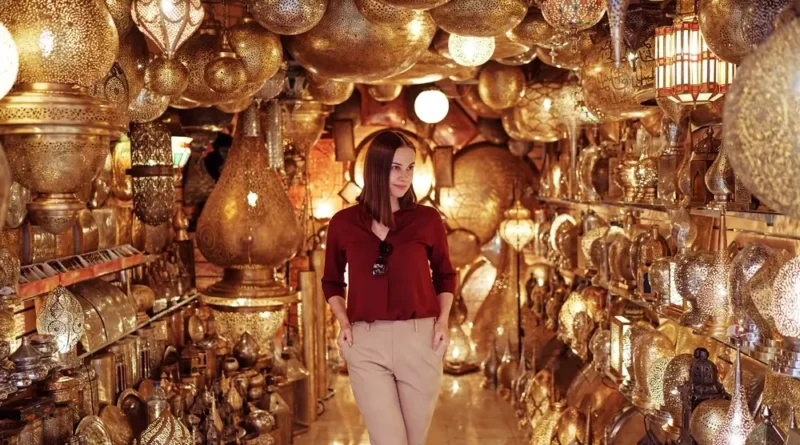From Fez to Your Home, Laiton Wonderland: Exploring the Enchanting World of Metal Magic
Introduction:
Morocco, a land where ancient whispers mingle with vibrant modernity, is a treasure trove of captivating artistry. Among its many dazzling facets, Moroccan laiton craft, also known as brass craftsmanship, shines with a timeless allure. This intricate metalworking tradition, steeped in centuries of history and meticulous technique, transforms humble brass into objects of breathtaking beauty and enduring value.
Table of Contents
A Tapestry Woven Through Time:
The origins of Moroccan laiton craft can be traced back to the Berber tribes, who skillfully fashioned everyday objects and adornments from readily available brass. Over time, this practical skill blossomed into an art form, influenced by diverse cultural currents. Andalusian artisans introduced intricate geometric patterns, while Islamic influences imbued laiton with sacred motifs and verses from the Quran. This rich tapestry of influences woven through time is evident in the stunning diversity of Moroccan brass work today.
Laiton craft: A Symphony of Form and Pattern
Moroccan laiton is not merely metal; it is a canvas for the soul. Traditional artisans, known as maalems, weave a symphony of form and pattern through their time-honored techniques. From the rhythmic hammering that shapes the raw brass to the delicate chiseling that brings forth intricate designs, each step is a testament to generations of accumulated skill.
A Language of Ornamental Delights:
The visual language of Moroccan laiton is as rich and varied as its history. Geometric patterns, inspired by Islamic architectural motifs, dance across surfaces, often interspersed with stylized floral and vegetal forms. Arabic calligraphy, imbued with spiritual significance, adds another layer of depth and meaning. These motifs, meticulously etched or chiseled onto the brass, create a mesmerizing interplay of light and shadow, transforming everyday objects into miniature masterpieces.
For the best Moroccan Brass crafts, please visit our store.
From Humble Tools to Exquisite Creations:
The tools of the maalem are as simple as they are effective. A heavy hammer, wielded with practiced precision, shapes the brass into desired forms. Chisels of varying sizes breathe life into intricate designs, while files smooth and refine the finished work. Tin solder, applied with practiced ease, joins pieces together, while a final burnishing with acid or natural materials lends the brass its warm, inviting glow.
Beyond Function, a Celebration of Life:
While some pieces of Moroccan laiton serve practical purposes, such as trays, plates, and lamps, others transcend mere utility to become expressions of cultural identity and artistic virtuosity. Jewelry boxes, adorned with intricate patterns and shimmering with inlaid gems, are treasured keepsakes passed down through generations. Incense burners, their smoke curling skyward through delicately pierced designs, fill homes with the evocative scent of tradition. And ornate lanterns, casting intricate shadows on nearby walls, transform everyday spaces into enchanting realms of light and artistry.
Preserving a Legacy, Supporting the Future:
The enduring legacy of Moroccan laiton craft faces challenges in the modern world. Mass-produced goods and changing tastes threaten to eclipse the meticulous skill and artistry of the maalem. However, a growing appreciation for handmade crafts and cultural heritage is fueling a wave of support for Moroccan laiton. Artisan cooperatives are springing up, providing platforms for maalem to showcase their work and reach a wider audience. Educational initiatives are ensuring that the secrets of this ancient craft are passed down to future generations.
Conclusion: An Enduring Enchantment
Moroccan laiton craft is more than just beautiful objects; it is a living testament to the enduring power of human creativity and cultural heritage. In every intricate pattern, every meticulously hammered curve, lies a story whispered through generations. Owning a piece of Moroccan laiton is not just acquiring an object; it is embracing a legacy, a conversation with the past that resonates with the present and whispers promises of the future.
Let the Enchantment Begin:
If you yearn to experience the magic of Moroccan laiton firsthand, visit the bustling souks of Fes or Marrakech. Here, amidst the vibrant tapestry of sights and sounds, you will find the workshops of the maalem. Witness their skill firsthand, lose yourself in the mesmerizing dance of hammer and chisel, and perhaps, just perhaps, find a piece of Morocco to carry in your heart, forever.
For the best Moroccan laiton crafts, please visit our store.
FAQ’s
- What is the historical origin of Moroccan laiton craft?
Moroccan laiton craft originated with the Berber tribes, who skillfully crafted everyday objects and adornments from brass. Over time, it evolved into an art form influenced by Andalusian artisans and Islamic motifs.
- Who are the traditional artisans responsible for Moroccan laiton craft?
Traditional artisans, known as maalems, are responsible for Moroccan laiton craft. They utilize time-honored techniques, including rhythmic hammering and delicate chiseling, to create intricate designs.
- What visual elements characterize Moroccan laiton craft?
Moroccan laiton craft is characterized by geometric patterns inspired by Islamic architectural motifs, stylized floral and vegetal forms, and Arabic calligraphy. These motifs are meticulously etched or chiseled onto brass surfaces.
- What tools do maalems use in the creation of Moroccan laiton?
Maalems use simple yet effective tools, including a heavy hammer for shaping, chisels for intricate designs, and files for refining. Tin solder is applied to join pieces, and a final burnishing with acid or natural materials gives the brass its warm glow.
- How is Moroccan laiton more than just utilitarian objects?
While some Moroccan laiton pieces serve practical purposes, such as trays and lamps, others transcend utility, becoming expressions of cultural identity and artistic virtuosity. They include jewelry boxes, incense burners, and ornate lanterns, each telling a unique story.

